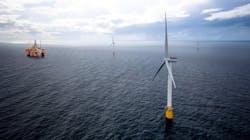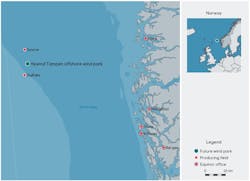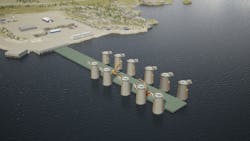Floating offshore wind park to power two major North Sea field centers
Cleaner energy will cut emissions from Gullfaks, Snorre platforms
Jeremy Beckman * Editor, Europe
Hywind Tampen will be the world’s largest floating offshore wind farm, and the first designed specifically for powering oil and gas production platforms. The 11 wind turbines in the Norwegian North Sea, supported by moored concrete hulls, will provide 88 MW of power to five platforms at the Gullfaks and Snorre fields. This will represent 35% of the platforms’ annual power needs, with scope to increase the percentage during periods of higher winds. Construction of the substructures started earlier this year at Aker Solutions’ drydock facility in Stord: the completed offshore wind park is due to transmit first electricity during the fall of 2022.
Norway’s government has been pushing increasingly for ‘cleaner’ power at the country’s major offshore field centers. To date this has been supplied directly from the shore through subsea power cables, but other fields undergoing electrification such as Troll are closer to the coast. The Hywind Tampen wind park will be located much farther out – 140 km (87 mi) offshore – between the Gullfaks and Snorre field centers, in water depths of up to 300 m (984 ft).
Operator Equinor estimates that the electricity generated will meet around 35% of the two fields’ needs, and will replace power currently provided by the platforms’ gas turbines. Use of these turbines will be scaled back, reducing annual CO2 emissions from the two fields by around 200,000 metric tons (220,462 tons), and annual nitrogen-oxide emissions by 1,000 metric tons (1,102 tons). Another key driver of the project has been securing government approval for plans to extend production from Gullfaks out to 2036 and from Snorre to 2040 – up to 20 years more than envisaged in the original development cases.
Most of the offshore wind turbines operating worldwide are fixed via foundations to the seafloor in water depths of less than 60 m (197 ft). The new generation of floating wind turbines will operate farther out at sea, where the winds are stronger, but water depths render bottom-fixed designs uneconomic. Hywind is based on a spar buoy design with the stability provided by gravity.
During the 2000s Norsk Hydro (later merged with Statoil) began work on the concept, including the motion control system, with researchers in Norway in the 2000s. The first test of Hywind technology was at SINTEF’s Ocean Basin laboratory in Trondheim in 2005. Four years later, the Hywind Demo was installed offshore Karmøy, comprising a single Siemens 2.3 MW turbine with 85-m (279-ft) rotor blades, connected to a slender cylindrical substructure with three mooring lines. This facility, the first floating turbine to be connected to Norway’s grid, operated successfully for eight years, producing more than 40 GWh, in wind speeds of 40 m/s (131 ft/s) and wave heights of up to 19 m (62 ft). It was sold to subsea connector specialist Unitech in 2019 for research purposes.
The next evolution of the concept was the 30-MW Hywind Scotland pilot, in which floating structures supported five 6-MW Siemens turbines with a rotor diameter of 154 m (505 ft), with an overall height of 253 m (830 ft). These were installed via suction anchors across a 4-sq km (1.54-sq mi) site 25 km (15.6 mi) offshore Peterhead in the UK central North Sea in water depths of up to 129 m (423 ft), with average wind speeds of 10 m/s (33 ft/s), and wave heights of 1.8 m (5.9 ft). The turbines are connected via inter-array cables and a 30-km (18.6-mi) long export cable to a shore landfall linked to the grid system, with a transmission voltage of 33 kV. Equinor and Abu Dhabi-based Masdar jointly invested NOK2 billion ($228 million) in the project, which began operations in October 2017, supplying power to around 20,000 homes. Hywind Scotland is said to have delivered a cost reduction per megawatt of up to 70% compared with the Hywind Demo.
In October 2019, Equinor and its partners in the Gullfaks and Snorre fields took a final investment decision on Hywind Tampen. The estimated cost was close to NOK5 billion ($569 million), with the Norwegian authorities pledging up to NOK2.3 billion ($262 million) via the government’s renewable technology facilitator Enova. In addition, the Norwegian business sector’s NOx fund offered up to NOK566 million ($64 million).
The 11 Siemens Gamesa 8.0-167 DD wind turbines, built in Cuxhavn, Germany, will feature a larger rotor, 167 m (548 ft) in diameter, with new aerodynamic 81.4-m (267-ft) long, fiberglass-reinforce epoxy blades providing a swept area of 21,900 sq m (235,730 sq ft) and pitch-regulated, variable-speed power. Siemens Gamesa’s design is based on the company’s direct drive technology, said to reduce the number and rating of wear-prone components in offshore turbines and thereby making them easier to maintain. Efficiency is said to be improved through use of a permanent magnet generator that does not need excitation power.
Another feature is the High Wind Ride Through (HWRT) system. When the wind speed is above 25 m/s (82 ft/s), wind turbines will typically shut down for self-protection. With the HWRT, however, the turbines slowly ramp down output power, leading to a smoother production rampdown and therefore a more reliable electrical grid. Finally, the lightweight nacelles housing the various generating components are said to be particularly suited to Hwyind Tampen’s ballast-stabilized floating foundations. Siemens Gamesa also has a five-year maintenance contract for the wind turbines.
Kvaerner (now Aker Solutions) won the FEED competition to supply the 11 floating concrete hull substructures and associated mooring systems. Previously the company had undertaken studies for Norsk Hydro during the Hywind Demo development, and also assembled the five floating Hywind Scotland wind turbines, which featured steel hulls. For Hywind Tampen, Equinor has opted for concrete, which according to Aker Solutions has reduced maintenance requirements compared with steel.
Aker Solutions’ detail design for the Hywind Tampen hulls, moorings, and anchors is based on Equinor’s conceptual design. The hulls, each weighing around 8,800 metric tons (excluding ballast), will be 107.5 m (353 ft) tall and 18.8 m (61.7 ft) in diameter. Initial construction will take place at Stord, with the bottom sections then floated to a site at Dommersnes in the Vindafjord where construction will be completed. Finally, the wind turbines will be installed on top of the concrete hulls at Gulen to the north. Aker Solutions expects to achieve improved construction efficiency through speeding up the slip forming process, with integration of j-tube supports also taking place during slip forming. Building 11 concrete structures as opposed to one should bring further benefits in terms of logistics and the re-use of forms.
According to the company, a floating offshore wind solution has to be tailored to each turbine and the environmental conditions at the offshore location. The chief technical challenges relate to control of the wind turbine and the higher loads imposed on the structure due to the motions. Each Hywind Tampen floating wind turbine will be held in place by three mooring lines, with the attachment point below water on the hull. Mooring brackets will be fixed to steel embedment plates cast into the concrete walls in a traditional way.
Aker Solutions will produce the suction anchors at its yard in Verdal, while Vicinay and Bridon-Bekaert Ropes Group will supply the chains and sheathed steel spiral strand product for the 35 mooring lines (including two spares), all designed for long-term service.
A 50-50 joint venture between Aker Solutions and DOF Subsea will execute the full offshore installation scope. Duties will comprise assembly site management, installation of anchors and mooring lines, tow-out of the floating wind turbines and hookup to the mooring systems. All construction/installation work is due to be completed by spring 2022, followed by assembly and tow to the offshore location in the Tampen Area that summer. Each floating wind turbine will be installed one at a time – not in batches – with DOF Subsea planning to use various vessels from its fleet, including the Skandi Sansen.
JDR Cable Systems is responsible for design and manufacture of the 66-kV dynamic inter-array cables and the static and export cables (including breakaway systems) between the wind park and the two field centers. In 2018 the company delivered what it claimed was the world’s first dynamic 66-kV technology/breakaway system to the WindFloat Atlantic floating wind farm. For Hywind Tampen, one of the main challenges is the dynamic stresses that the cables will need to withstand in this area of the North Sea. Also, the water depth – greater than for any previous floating wind farm project – means that the cable accessories must be engineered to withstand higher water pressures.
The 2.5-km (1.55-mi) long dynamic array cables will connect to the 11 turbines in a loop, while the two static 12-9 km (8-mi) and 16-km (9.9-mi) export cables will link the loop to the Snorre A and Gullfaks A platforms. JDR is manufacturing the cables and accessories at its plant in Hartlepool, northeast England, while parent company TFKable makes the cables’ power cores in Bydgoszcz, Poland.
Wood is responsible for delivering the topsides modifications at the Snorre A and Gullfaks A platforms needed to integrate the wind park with existing systems powering the facilities. Wood’s scope includes installation of certain equipment on the floating wind turbines and upgrades to the onshore control room in Bergen that will remotely operate the wind farm. Wood has subcontracted Goodtech to provide a SCADA system, including implementation of Equinor’s motion control system, designed to optimize operations via a patented blade pitch control that dampens out motions. Goodtech also worked with Equinor on the Hywind Demo and Hywind Scotland.
In addition, Wood has subcontracted Vysus Group, formerly part of Lloyd’s Register, to lead the human factors process for the human-machine-interface design on the platforms and in the onshore control room. Vysus Group will also handle human factor analysis related to the new dedicated control room at Bergen, which will be co-located alongside an existing control room serving Equinor’s normally unmanned Valemon field platform.
Aside from helping the various partners in the Gullfalks and Snorre fields to fulfil their emissions reductions obligations, Equinor views Hywind Tampen as an important step toward delivering industrialized solutions and cutting the costs of future offshore wind power projects. The development and the construction process are seen effectively as a test bed for further development of floating wind via the use of new and larger wind turbines, new installation techniques, simplified moorings, concrete substructures, and the integration of wind power generation with gas-driven power.
Editor’s Note: For more information, please attend Offshore’s upcoming Top Energy Transition Strategies webcast, which will be held on Dec. 15. It’s free to attend, simply register here.About the Author
Jeremy Beckman
Editor, Europe
Jeremy Beckman has been Editor Europe, Offshore since 1992. Prior to joining Offshore he was a freelance journalist for eight years, working for a variety of electronics, computing and scientific journals in the UK. He regularly writes news columns on trends and events both in the NW Europe offshore region and globally. He also writes features on developments and technology in exploration and production.



